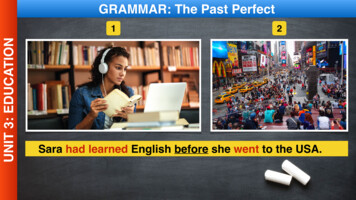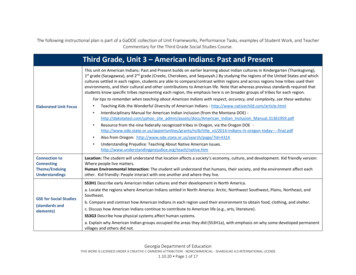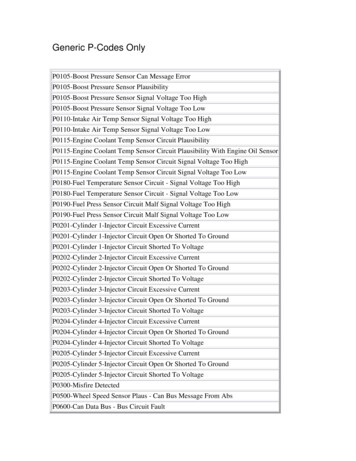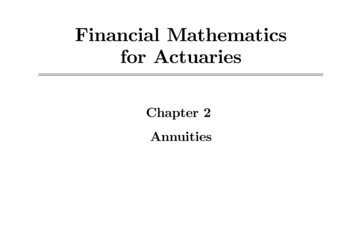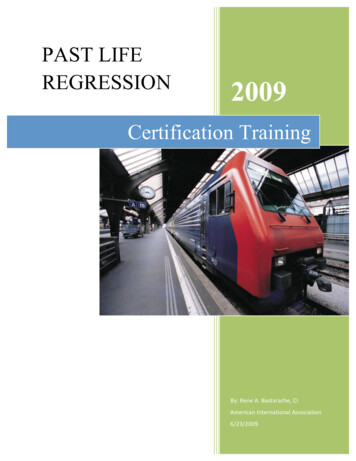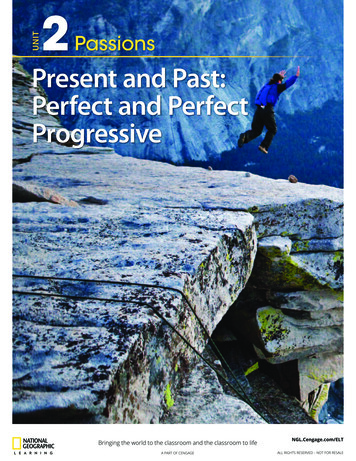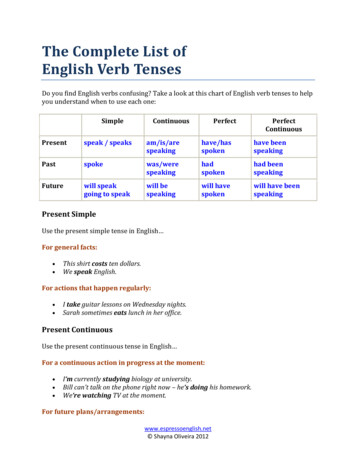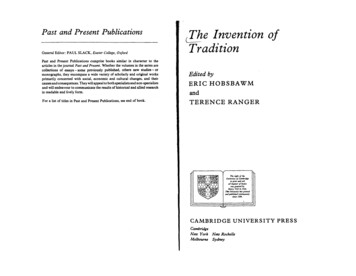
Transcription
Past and Present PublicationsThe Invention ofLGeneral Editor: PAUL SLACK, Exeter College, OxfordPast and Present Publications comprise books similar in character to thearticles in the journal Pasf and Present. Whether the volumes in the series arecollections of essays - some previously published, others new studies - ormonographs, they encompass a wide variety of scholarly and original worksprimarily concerned with social, economic and cultural changes, and theircausesand consequences.They will appealto both specialistsand non-specialistsand will endeavour to communicatethe results of historical and allied researchin readable and lively form.For a list of titles in Past and Present Publications, see end of book.TraditionEdited byERIC HOBSBAWMandTERENCE RANGERCAMBRIDGE U N I V E R S I T Y PRESSCambridgeNew York New RochelleMelbourne Sydney
Published by the Press Syndicate of the University of CambridgeThe Pitt Building, Trumpington Street, Cambridge CB2 IRP32 East 57th Street, New York, NY 10022, USA10 Stamford Road, Oakleigh, Melbourne 3 166, Australia0 E. J. Hobsbawm 1983@ Hugh Trevor-Roper 19830 Prys Morgan 1983'0 David Cannadine 1983@ Bernard S. Cohn 1983@ Terence Ranger 1983First published 1983First paperback edition 1984-Reprinted 1985, 1986, 1987, 1988Contents.Is\i",L f l ! s "bK"G7-4s%/zS8Printed in Great Britain by theUniversity Press, Cambridge1 Introduction: Inventing TraditionsThe invention of tradition - (Past and present publications)2. Folklore - History1. Sociology11. Ranger, TerenceI. Hobsbawm, E. J.111. Series303.3'72 HM201ISBN 0 521 24645 8 hard coversISBN 0 521 26985 7 paperback1ERIC H O B S B A W M2 The Invention of Tradition: The Highland Tradition ofScotlandH U G H T R E V 0 R-R 0 P E R153 From a Death to a View: The Hunt for the Welsh Pastin the Romantic PeriodLibrary of Congress catalogue card number: 82-1471 1British Library cataloguing in publication datapage viContributors43PRYS MORGAN4 The Context, Performance and Meaning of Ritual: TheBritish Monarchy and the 'Invention of Tradition', c.1820-1 977101DAVID CANNADINE5Representing Authority in Victorian India165B E R N A R D S. C O H N6 The Invention of Tradition in Colonial Africa21 1TERENCE R A N G E R7 Mass-Producing Traditions: Europe, 1870-1914263ERIC H O B S B A W M309IndexvUPV
14ERIC H O B S B A W Mmust be novel, whatever the historic continuities of Jews or MiddleEastern Muslims, since the very concept of territorial states of thecurrently standard type in their region was barely thought of a centuryago, and hardly became a serious prospect before the end of WorldWar I. Standard national languages, to be learned in schools andwritten, let alone spoken, by more than a smallish Clite, are largelyconstructs of varying, but often brief, age. As a French historian ofFlenfish language observed, quite correctly, the Flemish taught inBelgium today is not the language which the mothers and grandmothers of Flanders spoke to their children: in short, it is onlymetaphorically but not literally a ‘mother-tongue’. We should notbe misled by a curious, but understandable, paradox :modern nationsand all their impedimenta generally claim to be the opposite of novel,namely rooted in the remotest antiquity, and the opposite ofconstructed, namely human communities so ‘natural ’ as to requireno definition other than self-assertion. Whatever the historic or othercontinuities embedded in the modern concept of ‘France’ and ‘theFrench’ - and which nobody would seek to deny - these veryconcepts themselves must include a constructed or ‘invented’ component. And just because so much of what subjectivelymakes up themodern ’nation’ consists of such constructs and is associated withappropriate and, in general, fairly recent symbols or suitably tailoreddiscourse (such as ‘national history’), the national phenomenoncannot be adequately investigated without careful attention to the‘invention of tradition’.Finally, the study of the invention of tradition is interdisciplinary.It is a field of study which brings together historians, social anthropologists and a variety of other workers in the human sciences, andcannot adequately be pursued without such collaboration. Thepresent book brings together, in themain, contributions by historians.It is to be hoped that others will also find it useful.The Invention of Tradition: TheHighland Tradition of Scotland2.H U G H T R E V 0 R-ROP ERToday, whenever Scotchmen gather together to celebrate theirnational identity, they assert it openly by certain distinctive nationalapparatus. They wear the kilt, woven in a tartan whose colour andpattern indicates their ‘clan’; and if they indulge in music, theirinstrument is the bagpipe. This apparatus, to which they ascribe greatantiquity, is in fact largely modern. It was developed after, sometimeslong after, the Union with England against which it is, in a sense,a protest. Before the Union, it did indeed exist in vestigial form; butthat form was regarded by the large majority of Scotchmen as a signof barbarism : the badge of roguish, idle, predatory, blackmailingHighlanders who were more of a nuisance than a threat to civilized,historic Scotland. And even in the Highlands, even in that vestigialform, it was relatively new: it was not the original, or the distinguishing badge of Highland society.Indeed, the whole concept of a distinct Highland culture andtradition is a retrospective invention. Before the later years of theseventeenth century, the Highlanders of Scotland did not form adistinct people. They were simply the overflow of Ireland. On thatbroken and inhospitable coast, in that archipelago of islands largeand small, the sea unites rather than divides and from the late fifthcentury, when the Scots of Ulster landed in Argyll, until themid-eighteenth century, when it was ‘opened up’ after the Jacobiterevolts, the West of Scotland, cut off by mountains from the East,was always linked rather to Ireland than to the Saxon Lowlands.Racially and culturally, it was a colony of Ireland.Even politically these two Celtic societies, of Ireland and theWestern Highlands, merged into each other. The Scots of Dalriadaretained, for a century, their foothold in Ulster. The Danes ruledequally over the Western Islands, the coasts of Ireland and the Isleof Man. And in the later Middle Ages the Macdonald Lords of theIsles were nearer and more effective rulers both in Western Scotlandand in Northern Ireland than their nominal sovereigns, the kings of15
16H U G H TREVOR-ROPERScotland and England. Under their rule, the Hebridean culture waspurely Irish. Their hereditary bards, physicians, harpers (for theirmusical instrument was the harp, not the pipes) came from Ireland.’Even after the destruction of that lordship, the Macdonalds continuedto be a force in both countries. It was not till the mid-seventeenthcentury that the Plantation of Ulster under English authority, andthe rise of the Campbells to hegemony in the Western Highlands,broke that potential political unity. But the cultural unity, thoughweakened, continued. In the eighteenth century, the Western Islandswere still essentially an Irish overflow, and the Gaelic languagespoken there was regularly described, in the eighteenth century, asIrish.Being a cultural dependency of Ireland under the ‘foreign’, andsomewhat ineffective, rule of the Scottish crown, the Highlands andIslands of Scotland were culturally depressed. Their literature, suchas it was, was a crude echo of Irish literature. The bards of theScottish chieftains came from Ireland or went thither to learn theirtrade. Indeed, we are told by an early eighteenth-century writer - anIrishman - that the Scottish bards were the rubbish of Irelandperiodically cleared out of Ireland and deposited in that convenientdump.2 Even under the oppressive rule of England in the seventeenthand eighteenth centuries, Celtic Ireland remained, culturally, anhistoric nation while Celtic Scotland was, at best, its poor sister. Ithad - could have - no independent tradition.The creation of an independent Highland tradition, and theimposition of that new tradition, with its outward badges, on thewhole Scottish nation, was the work of the later eighteenth and earlynineteenth centuries. It occurred in three stages. First, there was thecultural revolt against Ireland: the usurpation of Irish culture andthe re-writing of early Scottish history, culminating in the insolentclaim that Scotland - Celtic Scotland - was the ‘mother-nation’ andIreland the cultural dependency. Secondly, there was the artificialcreation of new Highland traditions, presented as ancient, originaland distinctive. Thirdly, there was the process by which these newtraditions were offered to, and adopted by, historic Lowland Scotland :the Eastern Scotland of the Picts, the Saxons and the Normans.The first of these stages was achieved in the eighteenth century.The claim that the Celtic, Irish-speaking Highlanders of ScotlandSee J. Bannerman, ‘The Lordship of the Isles’, in Jennifer Brown (ed.), ScoftishSociety m the 15th Century (1977).A Collection of Several Pieces by Mr John Toland (1726), i, pp. 25-9.The Highland Tradition of Scotland17were not merely invaders from Ireland in the fifth century A.D., buthad an ancient history in Scotland and were in fact the Caledonianswho had resisted the Roman armies, was of course an old legendwhich had done good service in the past. It was effectively refutedin 1729 by the first and greatest of Scottish antiquaries, the JacobiteLmigrL priest, Thomas Innes. But it was reasserted in 1738 by DavidMalcolm3 and, more effectively,in the 1760%by two writers of thesame surname: James Macpherson, the ‘translator’ of Ossian, andthe Rev. John Macpherson, minister of Sleat in the island of Skye.These two Macphersons, though unrelated, were known to eachother - James Macpherson had stayed with the minister on his visitto Skye in search of ‘Ossian’ in 1760, and the minister’s son,afterwards Sir John Macpherson, governor general of India, wouldbe his close friend and accomplicelater - and they worked in concert.Between them, by two distinct acts of bold forgery, they created anindigenous literature for Celtic Scotland and, as a necessary supportto it, a new history. Both this literature and this history, in so far asthey had any connection with reality, had been stslen from the Irish.The sheer effrontery of the Macphersons must excite admiration.James Macpherson picked up Irish ballads in Scotland, wrote an‘epic’ in which he transferred the whole scenario from Ireland toScotland, and then dismissed the genuine ballads thus maltreated asdebased modern compositions and the real Irish literature which theyreflected as a mere reflection of them. The minister of Sleat then wrotea Critical Dissertation in which he provided the necessary contextfor ‘the Celtic Homer’ whom his namesake had ‘discovered’: heplaced Irish-speaking Celts in Scotland four centuries before theirhistorical arrival and explained away the genuine, native Irishliterature as having been stolen, in the Dark Ages, by the unscrupulousIrish, from the innocent Scots. To complete the picture, JamesMacpherson himself, using the minister’s papers, wrote an ‘independent’zntroduction to theHistoryof Great BritainandZreland(l771)repeating the minister’s assertions. Of the success of the Macphersonsno more need be said than that they seduced even the normallycareful and critical Edward Gibbon, who acknowledged as his guidesin early Scottish history those ‘two learned Highlanders’, JamesMacpherson and the Rev. John Macpherson, and thus perpetuatedwhat has rightly been called ‘a chain of error in Scottish history’.4David Malcolm, Dissertations on the Celtic Languages (1738).E . Gibbon, Decline and Fall of the Roman Empire, Everyman edn, ii, p. 496;M. V. Hay, A Chain of Error in Scottish History (1927).
18HUGH TREVOR-ROPERIt took a full century to clear Scottish history - if it has ever beencleared - of the distorting and interdependent fabrications of the twoMacpher ons. Meanwhile, these two insolent pretenders hadachieved a lasting triumph: they had put the Scottish Highlanderson the map. Previously despised alike by the Lowland Scots, asdisorderly savages, and by the Irish as their unlettered poor kinsmen,they were now celebrated throughout Europe as a Kulturvolk which,when England and Ireland had been sunk in primitive barbarism, hadproduced an epic poet of exquisite refinement and sensibility, equal(said Madame de Stael), superior (said F. A. Wolf), to Homer. Norwas it only in literature that they had thus drawn the attention ofEurope. For once the links with Ireland had been cut, and theScottish Highlands had acquired - however fraudulently - an independent ancient culture, the way was open to signalize that independence by peculiar traditions. The tradition which was nowestablished was a peculiarity of dress.In 1805 Sir Walter Scott wrote, for publication in the EdinburghReview, an essay on Macpherson’s Ossian. In it he showed, characteristically, sound scholarship and good sense. He decisively rejectedthe authenticity of the epic which the Scottish literary establishmentin general, and the Highlanders in particular, continued to defend.But, in the same essay he remarked, parenthetically, that it wasundeniable that the ancient Caledonian of the third century A.D.had worn ‘a tartan philibeg’. In so rational and critical an essay, thisconfident assertionis surprising. Never before - as far as I know - hadsuch a claim been made. Even Macpherson had never suggested it:his Ossian had always been represented in a flowing robe, and hisinstrument, incidentally,had been not the bagpipe but the harp. Butthen Macpherson was himself a Highlander and he was a generationolder than Scott. This, in such a matter, made a great difference.When did the ‘tartan philibeg’, the modern kilt, come to be thecostume of the Highlander? The facts are not really in doubt,especially since the publication of Mr J. Telfer Dunbar’s excellentwork.6Whereas tartan - that is, cloth woven in a geometrical patternThus - as was pointed out by the most learned scholar in the subject, LudwigStem, in his important essay ‘Die Ossianischen Heldenlieder’, translated inTransactions of the Gaelic Society of Inverness, xxii (1897-8) - the article onMacpherson in the D.N.B. ‘homologates the views of imperfectly informedapologists’ and the Albanogaelic lexicographers have damaged their work bytaking part of their material from Macpherson’s ‘faulty and un-gaelic Ossian’:i.e. the spurious Gaelic version of Ossian’s poems published in 1807.J. Telfer Dunbar, History of the H i g h h i Dress (1962).The Highland Tradition of Scotland19of colours - was known in Scotland in the sixteenth century (it seemsto have come from Flanders and reached the Highlands through theLowlands), the philibeg - name and thing - is unknown before theeighteenth century. So far from being a traditional Highland dress,it was invented by an Englishman after the Union of 1707; and thedifferentiated ‘clan tartans’ are an even later invention. They weredesigned as part of a pageant devised by Sir Walter Scott in honourof a Hanoverian king; and owe their present form to two otherEnglishmen.Since the Scottish Highlanders were, in origin, merely Irishmenwho had crossed from one island to another, it is natural to supposethat originally their dress was the same as that of the Irish. Andindeed this is what we find. It is not till the sixteenth century thatany writer records any peculiarities of the Highland dress, but all theaccounts of that time are in substantial agreement. They show thatthe ordinary dress of the Highlanders was a long ‘Irish’ shirt (inGaelic, leine) which the higher classes - as in Ireland - dyed withsaffron (leine-croich); a tunic or failuin; and a cloak or plaid whichthe higher classes had woven in many colours or stripes but whichin general was of a russet or‘brown effect, as protective colouring inthe heather. In addition, the Highlanders wore shoes with a singlesole (the higher classes might wear buskins) and flat soft caps,generally blue. In battle, the leaders wore chain mail while the lowerclasses wore a padded linen shirt painted or daubed with pitch andcovered with deer skins. Besides this normal dress, chieftains andgreat men who had contact with the more sophisticated inhabitantsof the Lowlands might wear trews: a combination of breeches andstockings. Trews could only be worn out of doors in the Highlandsby men who had attendants to protect or carry them: they weretherefore a mark of social distinction. Both plaid and trews wereprobably of tartan.’In the course of the seventeenth century - the century in which thelink between the Highlands and Ireland was broken - the Highlandcostume was -changed. The changes occurred irregularly over thecentury. First, the long shirt fell into disuse. In the islands it wasreplaced by the Lowland coat, waistcoat and breeches early in thecentury.6 On the other hand, a Scottish minister long afterwards’ These accountscame from John Major, Historia Maioris Britanniae(l521);JamesLeslie, De Moribus et Gestis Scotorwn (1570); Lindsay of Pitscottie, Chronicle(1573);G. Buchanan, Rerum Scoticarm Historia (1 583); Nicolay d’Arfeville, LaNavigation du Roy dEscosse (1583). The evidence is set out in D. W. Stewart,Old and Rare Scottish Tartans (Edinburgh, 1893), Introduction.M. Martin, A Description of the Western I s l a d of Scotland (1703).
20IIH U G H TREVOR-ROPERregalled th4t the wild Highlanders in the Jacobite army which passedthrough his parish in 1715 wore ‘neither plaid nor philibeg’ butmerely a home-made close-fitting coat of one colour, stretchingbelow mid-leg, with a belt.9 This is the latest evidence, as far as Iknow, of the survival of the leine in Scotland.Throughout the seventeenth century, Highland armies fought inthe civil wars of Britain, and, whenever they are described, we findthat the officers wore trews while the common soldiers had their legsand thighs bare. Both officers and men wore the plaid, the formeras an upper garment, the latter covering the whole body, belted roundthe waist so that the lower part, below the belt, formed a kind of skirt.In this form, it was known as the breacan or ‘belted plaid’. Theessential factis that,asyet, there wasnomentionofthekilt,as we knowit. The alternative was the gentlemanly trews or the ‘servile’ beltedplaid.1 The name ‘kilt’ first appears twenty years after the Union. EdwardBurt, an English officer posted to Scotland as chief surveyor underGeneral Wade, then wrote a series of letters, mainly from Inverness,describing the character and customs of the country. In these he givesa careful description of the ‘quelt’, which, he explains, is not adistinct garment but simply a particular method of wearing the plaid,set in folds and girt round the waist to make of it a short petticoatthat reaches half-way down the thigh, and the rest is brought overthe shoulders and then fastened before. . .so that they make prettynear the appearance of the poor women in London when theybring their gowns over their heads to shelter them from the rain.This petticoat, Burt adds, was normally worn ‘so very short that ina windy day, goingvp a hill, or stooping, the indecency of it is plainlydiscovered’. His description makes it clear that he is describing notthe modern kilt but the belted plaid.Burt was explicit about the Highland dress because already, in histime, it was the object of political controversy. After the Jacobiterebellion of 1715 the British parliament had considered banning itby law, as the Irish dress had been banned under Henry VIII: such* John F’inkerton, Literary Correspondence (1830), i, p. 230. The minister was thelofather of the philosopher Adam Ferguson.This is shown by the evidence presented by Stewart, op. cit., p. 21. It is illustratedmost graphically in the supporters of the arms of Skene of that Ilk-twoHighlanders, one (a sword-bearing gentleman) wearing trews, the other in ‘aseMll habit’, i.e. a belted plaid (not as Stewart supposes a kilt: on this seeDunbar, op. cit., pp. 34-5).The Highland Tradition of Scotland21a ban, it was thought, would help to break up the distinct Highlandway of life and integrate the Highlanders into modern society.However, in the end the proposed law was not passed. The Highlanddress, it was conceded, was convenient and necessary in a countrywhere a traveller must ‘skip over the rocks and bogs and lie all nightin the hills’. It was also a necessity for the poor, for it was very cheap:‘a few shillings will buy this dress for an ordinary Highlander’ whocould never afford even the coarsest ‘Lowland suit’.It is ironical that if the Highland dress had been banned after ‘theFifteen’ instead of after ‘the Forty Five’, the kilt, which is nowregarded as one of the ancient traditions of Scotland, would probablynever have come into existence. It came into existence a few yearsafter Burt wrote, and very close to the area in which he wrote.Unknown in 1726, it suddenly appeared a few years later; and by1746 it was sufficiently well established to be explicitly named in theact of parliament which then forbade the Highland dress. Its inventorwas an English Quaker from Lancashire, Thomas Rawlinson.The Rawlinsons were a long-established family of Quaker ironmasters in Furness. By the early eighteenth century, in associationwith other prominent Quaker families - Fords, Crosfields, Backhouses - they controlled ‘a wide meshwork of furnaces and forges’ inLancashire. But their supplies of charcoal had run low and theyneeded wood for fuel. Fortunately, after the suppression of therebellion, the Highlands were being opened up, and the forests in thenorth could be exploited by the industry of the south. So in 1727Thomas Rawlinson made an agreement with Ian MacDonell, chiefof the MacDonells of Glengar@ near Inverness, for a thirty-one yearlease of a wooded area at Invergarry. There he built a furnace andsmelted the iron-ore which he shipped specially from Lancashire. Theenterprise was not an economic success: it was wound up afterseven years; but during those seven years, Rawlinson came toknow the area, established regular relations with the MacDonells ofGlengarry, and of course employed ‘ a throng of Highlanders’ to fellthe timber and work the furnace.”During his stay at Glengarry, Rawlinson became interested in theHighland costume but he also became aware of its inconvenience.The belted plaid might be appropriate to the idle life of theOn Rawlinson’s Scottish venture see Alfred Fell, The Early Iron Indusrry ofFurness and District (Ulverston, 1908), pp. 346ff.; Arthur Raistrick, Quakersin Science and Industry (1950), pp. 95-102.
22HUGH TREVOR-ROPERHighlanders - for sleeping in the hills or lying hidden in the heather.It was also conveniently cheap, since all agreed on the fact that thelower class could not afford the expense of trousers or breeches. Butfor men who had to fell trees or tend furnaces it was ‘a cumbrous,unwieldy habit’. Therefore, being ‘a man of genius and quick parts’,Rawlinson sent for the tailor of the regiment stationed at Invernessand, with him, set out ‘to abridge the dress and make it handy andconvenient for his workmen’. The result was the felie beg, philibeg,or ‘small kilt ’, which was achieved by separating the skirt from theplaid and converting it into a distinct garment, with pleats alreadysewn. Rawlinson himself wore this new garment, and his example wasfollowed by his associate, Ian MacDonell of Glengarry. After that,the clansmen, as always, obediently followed their chief, and theinnovation, we are told, ‘was found so handy and convenient thatin the shortest space the use of it became frequent in all the Highlandcountries and in many of the Northern Lowland countries also’.This account of the origin of the kilt was first given in 1768 by aHighland gentleman who had known Rawlinson personally. It waspublished in 1785 and excited no dissent.12It was confirmed by thetwo greatest authorities on Scottish customs then living,Ig and byindependent testimony, from the Glengarry family.14 It was notchallenged for another forty years. It has never been refuted. All theevidence that has since been accumulated is consistent with it.Pictorial evidence also comes to its aid, for the first person to bepainted wearing a recognizable modem kilt, not a belted plaid,appears in a portrait of Alexander MacDonell of Glengarry, the sonof the chief who was Rawlinson’s friend. It is interesting to note that,in that portrait, the kilt is worn not by the chief but by hisservant - thus emphasizing, once again, its ‘servile’ status.15 On allthis evidence, the best modern authorities accept the story as true.l8We may thus conclude that the kilt is a purely modern costume, firstdesigned, and first worn, by an English Quaker industrialist, and thatit was bestowed by him on the Highlanders in order not to preservetheir traditional way of life but to ease its transformation: to bringthem out of the heather and into the factory.I*l3l6The account is by Ivan Baillie of Abereachen, and it was published in theEdinburgh Magazine, March 1785 (vol. I, p. 235).I refer to Sir John Sinclair and John Pinkerton. See below p. 27.I refer to the evidence of the Sobieski Stuarts. See below p. 36.For the portrait see Dunbar, op. cit., pp. 69-70. It appears to have been paintedabout 1747.Dunbar, loc. cit.The Highland Tradition of Scotland23But if this was the origin of the kilt, another question immediatelyforces itself on our mind. What tartan did the kilted Quaker wear?Was a distinctive‘sett ’ or pattern of colours devised for a LancashireRawlinson, or did he become an honorary member of the clan ofMacDonell? Were there, indeed, any such ‘setts’ in the eighteenthcentury? When did the differentiation of patterns by clans begin?The sixteenth-centurywriters who first noticed the Highland dressclearly did not know any such differentiation. They describe theplaids of the chiefs as coloured, those of their followers as brown,so that any differentiation of colour, in their time, was by socialstatus, not by clan. The earliest evidence which has been adduced insupport of differentiation by clan is a remark by Martin Martin, whovisited the Western Islands at the end of the seventeenthcentury. ButMartin merely assigns different patterns to different localities: hedoes not differentiate them by clans; and in fact the evidence againstdifferentiationby clans is strong. Thus, a carefully painted series ofportraits of the different members of the Grant family by RichardWaitt in the eighteenth century shows all of them in different tartans;the portraits of the Macdonalds of Armadale show ‘at least sixdistinct setts of tartan’; and contemporary evidence concerning therebellion of 1745 - whether pictorial, sartorial or literary - shows nodifferentiationof clans, no continuity of setts. The only way in whicha Highlander’s loyalty could be discerned was not by his tartan butby the cockade in his bonnet. Tartans were a matter of private taste,or necessity, only.” Indeed, in October 1745, when the YoungChevalier was in Edinburgh with his army, the Caledonian Mercuryadvertised a ‘great choice of tartans, the newest patterns’. AsD. W. Stewart reluctantly admits,this is a great stumbling-block in the way of those who argue forthe antiquity of the patterns; for it seems peculiar that, when thecity was filled with Highlanders of all ranks and many clans, theyshould be offered not their ancient setts but ‘ a great choice of thenewest patterns’.Thus when the great rebellion of 1745 broke out, the kilt,.as. weknow it, was a recent English invention and ‘clan’ tartans did notexist. However, that rebellionmarked a change in the sartorial as wellas in the social and economic history of Scotland. After the rebellionhad been crushed, the British government decided at last to do whatThe evidence on this point is set out conclusively by H. F. McClintock, OldHighland Dress and Tartans, 2nd edn (Dundalk, 1940) and Dunbar, op. cit.
24H U G H TREVOR-ROPERhad been considered in 1715 (and indeed before) and to destroyfinally the independent Highland way of life. By the various acts ofparliament which followed the victory at Culloden not only were theHighlanders disarmed and their chiefs deprived of their hereditaryjurisdictions, but the wearing of Highland costume - ‘plaid, philibeg,trews, shoulder-belts. . .tartans or parti-coloured plaid or stuff’ - wasforbidden throughout Scotland under pain of imprisonment withoutbail for six months and, for a second offence, transportation for sevenyears.l8 This draconian law remained in force for thirty-five years,during which the whole Highland way of life quickly crumbled. In1773,when Johnson and Boswell made their famous tour, they foundthat they were already too late to see what they had expected, ‘apeople of peculiar appearance and a system of antiquated life’. Inthe whole of their tour, Johnson recorded, they had never seen thetartan worn. The law (of which he disapproved) had everywhere beenenforced. Even the bagpipe, he noted, ‘begins to be forgotten’. By1780 the Highland dress seemed extinct, and no rational man wouldhave speculated on its revival.However, history is not rational: or at least it is rational only inparts. The Highland costume did indeed die out among those whohad been accustomed to wear it. After a generation in trousers, thesimplepeasantry of the Highlands saw no reason to resume the beltedplaid or the tartan which they had once found so cheap andserviceable. They did not even turn to the ‘handy and convenient’new kilt. On the other hand, the upper and middle classes, who hadpreviously despised the ‘servile’ costume, now picked up withenthusiasm the garb which its traditional wearers had finallydis arded.’ In the years when it had been banned, some Highlandnoblemen had taken pleasure in wearing it, and being portray
ERIC HOBSBAWM 2 The Invention of Tradition: The Highland Tradition of Scotland From a Death to a View: The Hunt for the Welsh Past in the Romantic Period 4 The Context, Performance and Meaning of Ritual: The British Monarchy and the 'Invention of Tradition', c. 1820-1 9

